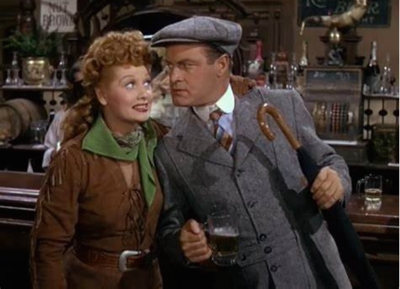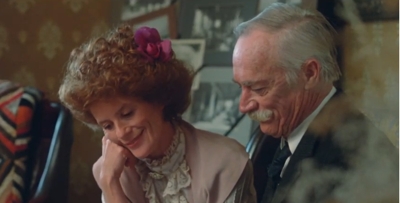Grade: B/B-
Western comedy
Not rated (would be G)
Families that watch I Love Lucy reruns on TV will enjoy seeing Lucille Ball in this Western comedy—the fourth film to be based on Harry Leon Wilson’s popular 1915 novel Ruggles of Red Gap, and the second feature film Ball made with comedian Bob Hope.The humor in this film is certainly a cousin to the antics home audiences loved about that classic TV series, which began airing in 1951.
Fancy Pants(1950) is the costumed follow-up to Sorrowful Jones (1949), and both films are pleasant diversions. Hope and Ball click together with a natural ease. Maybe that’s why the fast friends co-starred in four feature films and a made-for-TV movie, and also hosted each other on their TV series and specials. Their first film is still their best, but Fancy Pants isn’t far behind. And children will undoubtedly prefer Hope and Ball in Western getup and giddy-up to the duo’s earlier Damon Runyon racetrack comedy.
In this one, Ball is brassy and uncultured, but not to the point of annoyance (I’m thinking here of Debbie Reynolds in The Unsinkable Molly Brown or Shelley Winters in Pete’s Dragon). And Hope is Hope, his vaudevillian shtick honed to perfection over a series of “Road” pictures with Dorothy Lamour and Bing Crosby. Director George Marshall (Destry Rides Again, The Ghost Breakers) gives them the reins, too, so they can create comic moments reflective of their strengths.
In 1950, only John Wayne was earning more money at the box office than Hope. Here Hope plays a bad American actor working in London as a butler in a play, and when the whole mediocre cast is hired to pose as upper-crust Brits for an event, he’s mistaken for a real Butler and sees the opportunity as the role of a lifetime . . . and a way to pay the bills.
The film opens in England, where the matron of a newly rich Western family (Lea Penman) has taken her tomboyish daughter Agatha (Ball) to learn how to be more cultured and refined. The starter pistol for an often-used plot of mistaken identity is the telegram Mrs. Floud sends home that she is bringing a “gentleman’s gentleman”—which the whole town interprets as British royalty. Suddenly, Hope is an actor named Arthur Tyler playing the part of a butler named Humphrey who’s also playing the part of the Earl of Brimstead. And the complication? The town uses the Earl’s visit as a way to entice Pres. Theodore Roosevelt to make Big Squaw one of his very few stops on a tour of the West. Throw in a slow-building attraction between Agatha and Humphrey and a jealous cowboy (Bruce Cabot) who thinks Agatha is his “girl,” and the Western farce plays out better than anything Arthur Tyler had been a part of.
More



















